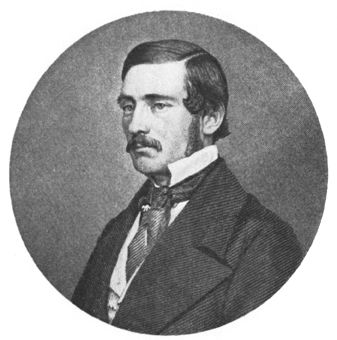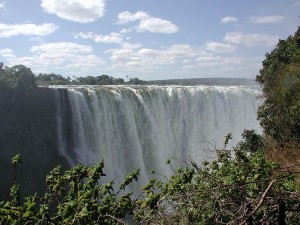Dr Livingstone I presume is the archetype of an explorer for most of us. The helmeted man at the head of the line of bearers fearlessly plunging into thick jungles to discover the world untouched by man. That is the way they write their histories, and that makes for the books that sell. Of course, most of us now realize that wherever Livingstone and his likes went, there was already a human population. In East Africa at the time, there was both the native population, and considerable numbers of Arabian businessmen to show the way to all the discoveries the British needed. And help finding lost explorers from time to time. The fact is probably that the major contribution of western explorers was the mapping of the continents. During the 18th and 19th Centuries maps were drawn like never before, and it was new maps, not one more round of Europe encircled by the edge of the world.
The Center for the History of Science at the Royal Swedish Academy of Sciences is the guardian of enormous archives of objects, maps, drawings, and manuscripts that will eventually help toward understanding how our knowledge of the world gradually developed over the last few Centuries. The Center is highlighting some of its material as “object of the month”, since a few months back. One of these objects is a map sent to the Academy by Charles Andersson in 1852. It is a map made by Oswell and Livingstone based on interviews with local informants. Interestingly, this map of southern Africa from 1852 shows the Victoria Falls. The falls that, legend has it, Livingstone discovered in 1855. Not, he already had a map. The local name of the falls is now rendered as Mosi-oa-Tunya, on the old map they appear as Mosioatunga.
 And who was Charles Andersson, by the way? Some may be familiar with Oreochromis andersonii. That is the fish named after him, but somehow, the author, Castelnau, misspelt the name by dropping one of the ses in Andersson. Karl Johan Andersson, Swedish,born 1827 in the county of Värmland, was the son of the English hunter and writer Llewellyn Lloyd and a Swedish girl, Caisa Andersdotter. Lloyd spent most of his adult life in Värmland hunting bears and writing about it. Karl studied Zoology at Lund University and learned taxidermy at the natural history museum in Göteborg. He somehow got the idea of going to the Africa, and stranded already in London he became a friend of a distant relative, Francis Galton, yes the very one who discovered the fingerprinting technique. Galton and Andersson went to Africa, and Andersson spent the rest of his life as a trader, hunter, collector and more in what is now Namibia and South Africa, and much of that time in the field. Andersson was not an ichthyologist. He did collect a lot of birds. Not less than 2523 bird specimens from him are in museum collections (Dean, Sandwidth & Milton, 2006). He sent 200 or more specimens to the Gothenburg museum in 1864, but the curator there didn’t bother to open the boxes. Andersson wrote a classical travel book, Lake Ngami, published 1856, based on travels including to Lake Ngami (already ‘discovered’ by Livingstone). His second travel book, Okavango River, from 1861, relates his own major discovery, the river of the same name. Or … did he discover it?
And who was Charles Andersson, by the way? Some may be familiar with Oreochromis andersonii. That is the fish named after him, but somehow, the author, Castelnau, misspelt the name by dropping one of the ses in Andersson. Karl Johan Andersson, Swedish,born 1827 in the county of Värmland, was the son of the English hunter and writer Llewellyn Lloyd and a Swedish girl, Caisa Andersdotter. Lloyd spent most of his adult life in Värmland hunting bears and writing about it. Karl studied Zoology at Lund University and learned taxidermy at the natural history museum in Göteborg. He somehow got the idea of going to the Africa, and stranded already in London he became a friend of a distant relative, Francis Galton, yes the very one who discovered the fingerprinting technique. Galton and Andersson went to Africa, and Andersson spent the rest of his life as a trader, hunter, collector and more in what is now Namibia and South Africa, and much of that time in the field. Andersson was not an ichthyologist. He did collect a lot of birds. Not less than 2523 bird specimens from him are in museum collections (Dean, Sandwidth & Milton, 2006). He sent 200 or more specimens to the Gothenburg museum in 1864, but the curator there didn’t bother to open the boxes. Andersson wrote a classical travel book, Lake Ngami, published 1856, based on travels including to Lake Ngami (already ‘discovered’ by Livingstone). His second travel book, Okavango River, from 1861, relates his own major discovery, the river of the same name. Or … did he discover it?
Andersson’s zoological magnum opus, Notes on the birds of Damaraland, was published posthumously by John Henry Guerney in 1872. Andersson died of dysentery and physical wounds in 1867 on his way back from a failed expedition to the Cunene River on the border between Angola and Namibia. Andersson’s life is full of misery, hardships, diseases, fights with employees and local chiefs, and the one drawback after the other. The most disappointing must have been the search for Lake Ngami, only to find it already found. It is a miracle he survived so long. His companion Axel W. Eriksson (1846-1901), also Swedish, carried on the zoological collection and brought a huge collection of southern African birds to to Vänersborgs Museum in Western Sweden (available in an online database with images, all in Swedish).
The consensus (remember the map above) must be that there is (and was) nothing to discover on this planet, really. That is why science is not so much about discovery. It is about exploration and communication. Showing what the world is like, drawing the maps and fitting the pieces together. Also, life can be much easier than that of Karl Johan Andersson.
Reference
Bjelfvenstam, B. 1994. Charles John Andersson. Upptäckare Jägare Krigare. Carlssons Bokförlag, Stockholm, 253 pp.
